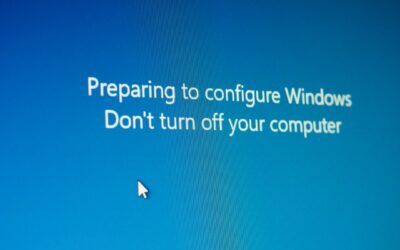Can you believe it’s been nearly a decade since Windows 10 was launched? 2015 was a year full of unforgettable moments—streaming platforms like Netflix, Hulu, and Amazon started dominating our screens, the infamous blue-and-black or white-and-gold dress debate took over the internet, and who could forget Left Shark at the Super Bowl? Amidst all this, Microsoft introduced Windows 10, which has been our trusty companion ever since.
But now, as we approach October 2025, it’s time to prepare for the end of Windows 10 support. After this date, Microsoft will no longer provide security updates, patches, or technical support for Windows 10. Planning ahead is key to keeping your systems secure and running smoothly. Are you prepared for this transition? Let’s dive into what the Windows 10 end of support means for you and how managed IT and cybersecurity solutions can help ensure a seamless transition.
Master Windows 10 End of Life With Managed IT Solutions
What Does Windows 10 End of Life Mean?
You might be wondering, “What does it mean that Windows 10 is going end of life?” Simply put, it means that Microsoft will stop providing security updates, patches, and technical support for Windows 10. This doesn’t mean your computer will stop working overnight, but it does mean that without these critical updates, your system will become increasingly vulnerable to security threats and operational issues.
Key Dates and What They Mean for Users
Mark your calendars for October 14, 2025. After this date, Windows 10 will no longer provide updates, making it essential for users to transition to a newer operating system to maintain security and efficiency.
The Difference Between EOL and End of Support
While mainstream support for Windows 10 ended earlier, reaching End of Life (EOL) means all updates and support will cease entirely. This final phase includes the end of security updates, which are vital for protecting your system against new threats.
How Managed IT Can Help
Transitioning from Windows 10 doesn’t have to be stressful. With the right IT management support, you can make it a smooth and efficient process. Managed IT services provide the expertise to plan and execute your upgrade while enhancing your cybersecurity and network security. Here’s how:
First, managed IT services help you identify and fix issues before they become big problems. By catching potential issues early, your operations continue running smoothly.
Regular updates and proactive measures keep your systems secure and efficient. No more worrying about vulnerabilities or outdated software—you’ve got it covered.
Staying ahead of deadlines is crucial. Expert planning and timely execution ensure you meet all your critical upgrade milestones without a hitch.
How To Protect Your PC and Software Post-Windows 10 EOL
As we approach the end of Windows 10 support, it’s crucial to understand how this impacts your PCs and software. Imagine your trusty old PC suddenly becoming more vulnerable to cyberthreats—sounds worrying, right? Here’s what you need to know to stay protected.
Your PCs running Windows 10 will still function, but they won’t get those all-important updates anymore. No more security patches means your system could become a prime target for cyberattacks. Think of it like leaving your front door unlocked—new vulnerabilities will stay open, putting your data and operations at significant risk.
Without security updates, your PC can become an easy target for cyberattacks. Any new vulnerabilities discovered will remain unpatched, posing significant risks to your data and operations. This can lead to data breaches, malware infections, and other cybersecurity issues.
Additionally, you won’t get new features or technical support from Microsoft. This means missing out on new applications or enhancements. Compatibility issues with evolving software might also arise, leading to decreased productivity and more frustration.
Running an unsupported operating system exposes your business to various risks, such as:
- Data Breaches: Increased likelihood of cyberattacks
- Compliance Issues: Potential noncompliance with industry regulations
- Operational Inefficiencies: Lack of access to new features that improve productivity
- Higher Costs: Increased costs associated with managing security risks and potential downtime
Options for Staying Supported on a Windows Operating System
With the end of Windows 10 support approaching, it’s essential to explore your options to stay supported on a Windows operating system.
Upgrade to Windows 11
One of the easiest options is upgrading to Windows 11. It offers better security, improved performance, and a fresh, modern look.
Check Your PC’s Compatibility
Before upgrading, you need to make sure your current PC meets the minimum requirements for Windows 11. Microsoft provides a handy PC Health Check tool to help you out.
Steps To Upgrade From Windows 10 to Windows 11 for Free
If your PC is compatible, upgrading is a breeze:
- Back up Your Data: Ensure all your important data is backed up.
- Check for Updates: Make sure your current Windows 10 is up to date.
- Use the Installation Assistant: Download and run the Windows 11 Installation Assistant from the Microsoft website.
- Follow the Prompts: Complete the upgrade process by following the on-screen instructions.
Consider a New PC
If your current PC doesn’t meet the requirements for Windows 11, it might be time to invest in a new one. A new PC will have the latest hardware and security features to keep you running smoothly.
Look Into the Windows 10 Extended Security Updates (ESU) Program
If you need more time to transition, Microsoft offers the Extended Security Updates (ESU) program. This provides critical security updates for Windows 10 for a limited time after the official end of support, giving you some breathing room while you plan your upgrade.
How To Ensure Compatibility With Microsoft 365 and Office Apps
As Windows 10 reaches its end of life, it’s essential to ensure your Microsoft 365 and Office apps continue to function smoothly and securely. Without updates or security patches, these apps can become vulnerable. Here’s how to keep everything running seamlessly:
Impact on Microsoft 365 Apps After Windows 10 EOL
When support for Windows 10 ends, your Microsoft 365 apps will stop receiving updates and security patches. This can increase the risk of security threats and cause functionality issues. Features might not work as intended, and compatibility problems could arise over time.
Options for Maintaining Support for Microsoft Office Apps
- Upgrade to Windows 11: The best way to ensure your Microsoft 365 apps remain supported and secure is by upgrading to Windows 11. Use the PC Health Check tool to check if your PC meets the requirements.
- Migrate Subscriptions to New Devices: If your current devices aren’t compatible with Windows 11, consider moving your Microsoft 365 subscriptions to new devices that support the latest operating system.
- Explore Microsoft 365 Subscription Options or Office 2021: Look into different Microsoft 365 plans or switch to Office 2021. These options provide additional features and ongoing support to meet your business needs.
By taking these steps, you can ensure your Microsoft 365 and Office apps stay secure and functional even after Windows 10 reaches its end of life.
Why Proactive IT Support Matters
Navigating the end of support for major software services like Windows 10 can be challenging. Proactive IT support is essential for keeping your business secure, efficient, and ready for technological shifts. Here’s how it benefits your organization:
How Proactive IT Support Benefits Your Business
Proactive IT support identifies and resolves potential issues before they become major problems. This means fewer disruptions and more efficient operations. Regular updates keep your systems secure, protecting you from cyberthreats. And with careful planning, you’ll always stay ahead of critical deadlines, ensuring necessary upgrades happen on time.
Advantages of Partnering With an IT Provider
Having an IT partner means you get continuous monitoring, so issues are detected and addressed immediately. They manage strategic planning and execution of system upgrades with minimal disruptions, allowing you to focus on what you do best—running your business.
Reducing Stress and Ensuring Smooth Transitions
Proactive IT support minimizes downtime and operational disruptions, providing you with peace of mind. Expert management ensures smooth transitions, like upgrading from Windows 10, making the whole process stress-free.
Ready To Transition Smoothly? Partner With Mega-Byte Today!
As the end of Windows 10 support approaches, it’s crucial to prepare your business for the future. Mega-Byte’s proactive IT support services will help you navigate this transition seamlessly, ensuring your systems stay secure and efficient. Don’t wait—take action now to protect your business and stay ahead of IT challenges. Contact us today for a consultation and discover how we can help your business thrive in the post-Windows 10 era.

